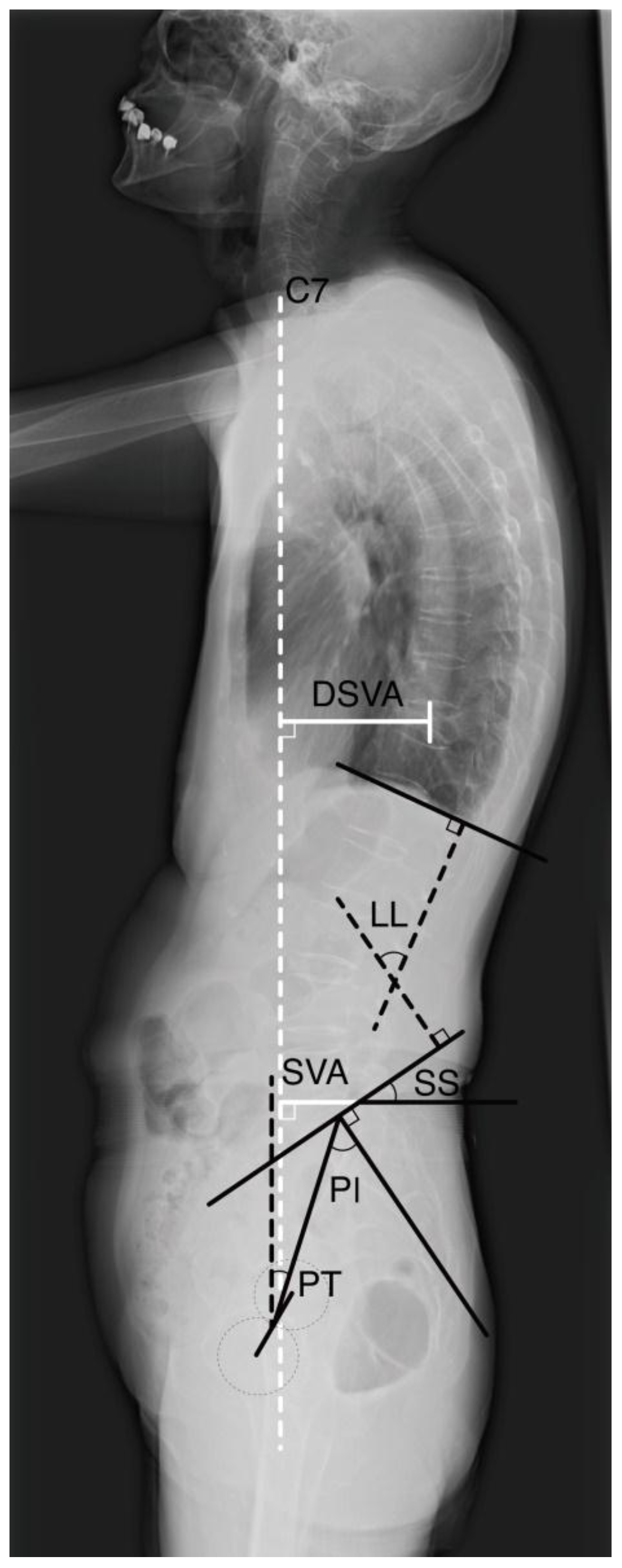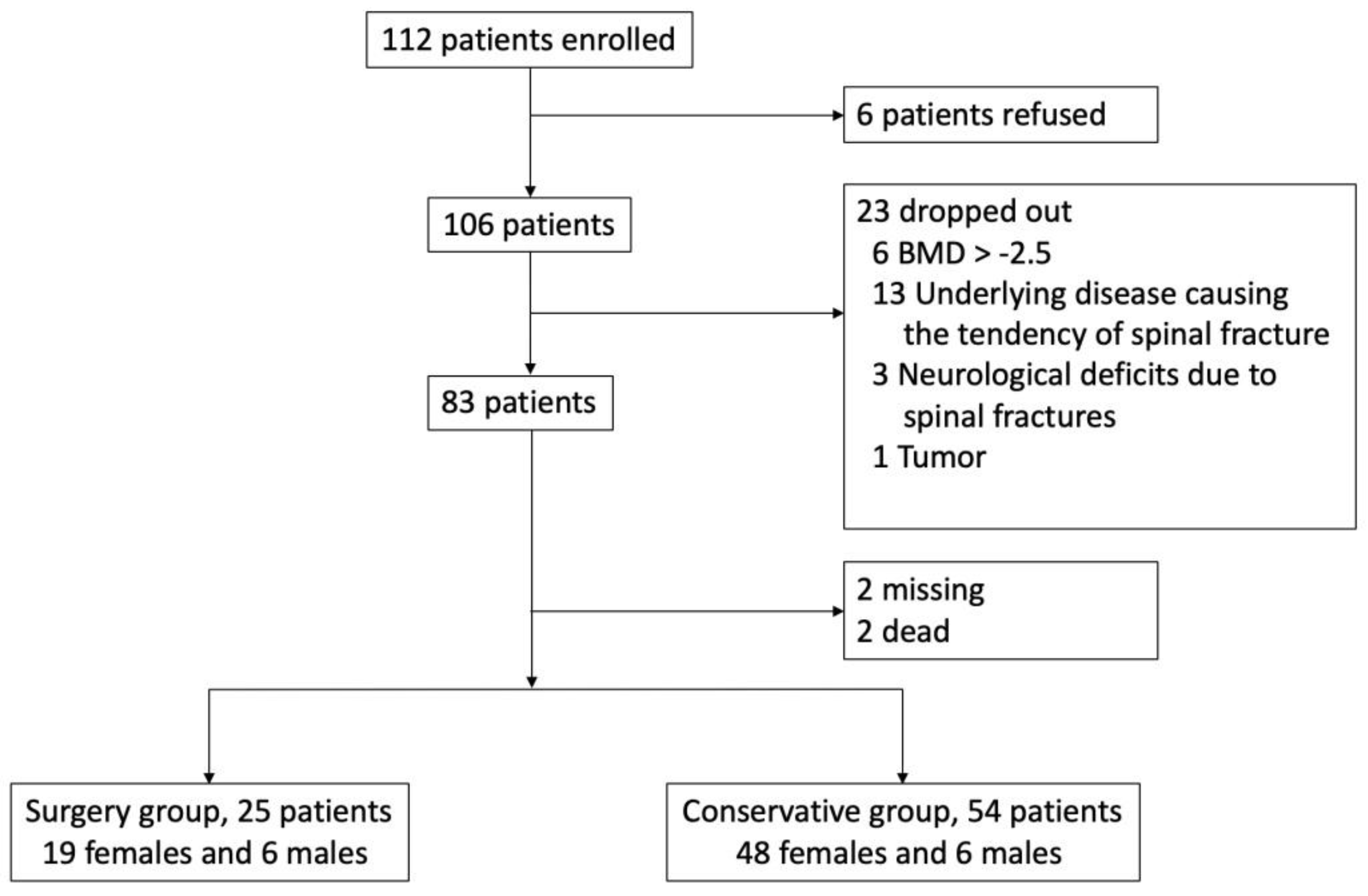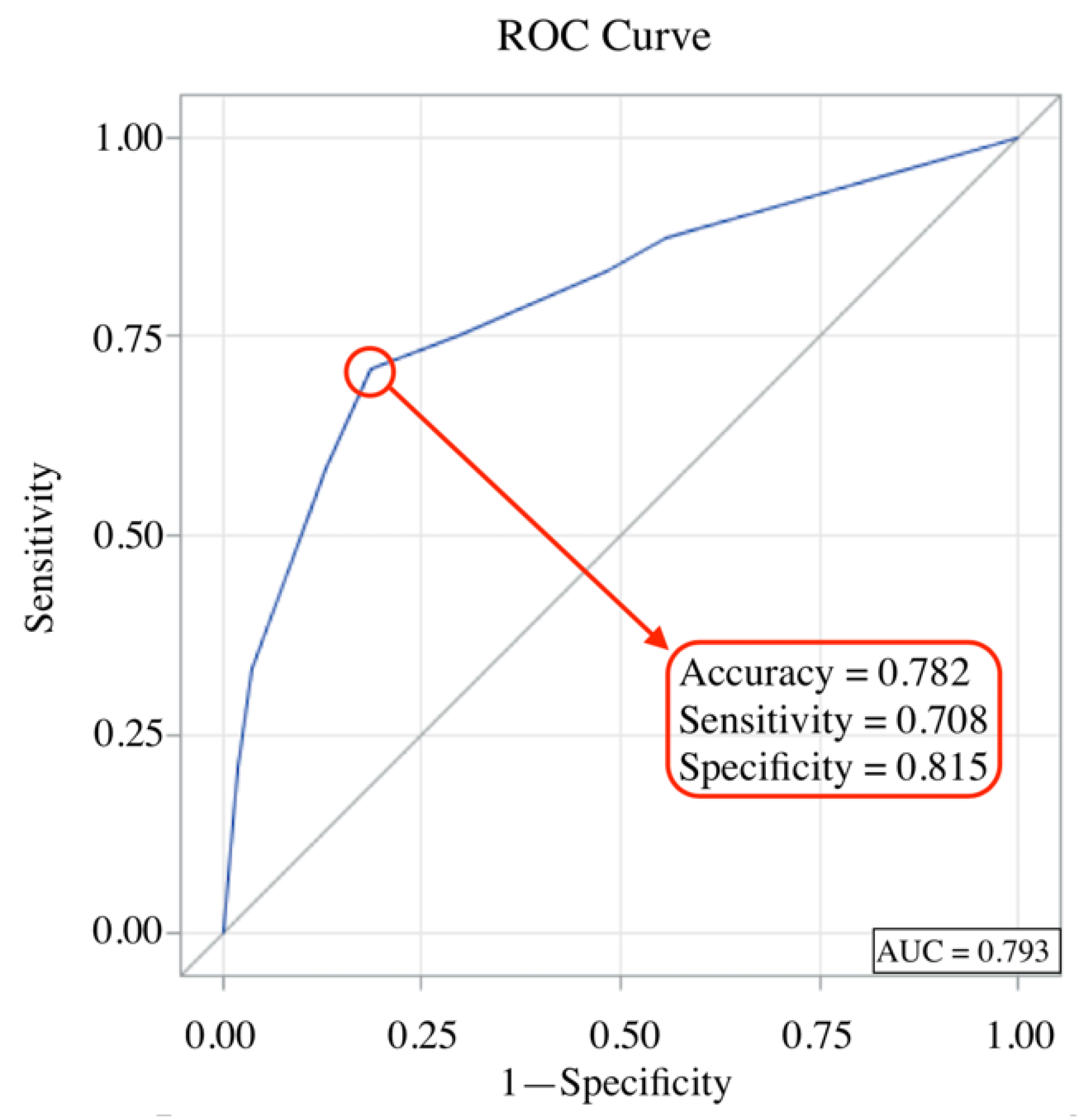Factors Predicting the Surgical Risk of Osteoporotic Vertebral Compression Fractures
Abstract
1. Introduction
2. Experimental Section
3. Results
3.1. Patients
3.2. Spinopelvic Parameters and Sagittal Alignment
3.3. Prediction of Risk of Surgical Intervention
4. Discussion
5. Conclusions
Author Contributions
Acknowledgments
Conflicts of Interest
References
- Cooper, C.; Atkinson, E.J.; O’Fallon, W.M.; Melton, L.J., 3rd. Incidence of clinically diagnosed vertebral fractures: A population-based study in Rochester, Minnesota, 1985–1989. J. Bone Miner. Res. 1992, 7, 221–227. [Google Scholar] [CrossRef]
- Burge, R.; Dawson-Hughes, B.; Solomon, D.H.; Wong, J.B.; King, A.; Tosteson, A. Incidence and economic burden of osteoporosis-related fractures in the United States, 2005–2025. J. Bone Miner. Res. 2007, 22, 465–475. [Google Scholar] [CrossRef] [PubMed]
- Gold, D.T. The clinical impact of vertebral fractures: Quality of life in women with osteoporosis. Bone 1996, 18, 185S–189S. [Google Scholar] [CrossRef]
- Roberto, K.A. Women with osteoporosis: The role of the family and service community. Gerontologist 1988, 28, 224–228. [Google Scholar] [CrossRef]
- Longo, U.G.; Loppini, M.; Denaro, L.; Maffuli, N.; Denaro, V. Conservative management of patients with an osteoporotic vertebral fracture: A review of the literature. J. Bone Jt. Surg. Br. 2012, 94, 152–157. [Google Scholar] [CrossRef] [PubMed]
- Prather, H.; Hunt, D.; Watson, J.O.; Gilula, L.A. Conservative care for patients with osteoporotic vertebral compression fractures. Phys. Med. Rehabil. Clin. N. Am. 2007, 18, 577–591. [Google Scholar] [CrossRef]
- Hsieh, M.K.; Chen, L.H.; Chen, W.J. Current concepts of percutaneous balloon kyphoplasty for the treatment of osteoporotic vertebral compression fractures: Evidence-based review. Biomed. J. 2013, 36, 154–161. [Google Scholar] [CrossRef]
- Muijs, S.P.; van Erkel, A.R.; Dijkstra, P.D. Treatment of painful osteoporotic vertebral compression fractures: A brief review of the evidence for percutaneous vertebroplasty. J. Bone Jt. Surg. Br. 2011, 93, 1149–1153. [Google Scholar] [CrossRef]
- Old, J.L.; Calvert, M. Vertebral compression fractures in the elderly. Am. Fam. Phys. 2004, 69, 111–116. [Google Scholar]
- Dorgan, J.C. The Pediatric Spine; Principles and Practice. Arch. Dis. Child. 1994, 70, 455. [Google Scholar] [CrossRef][Green Version]
- Mehta, V.A.; Amin, A.; Omeis, I.; Gokaslan, Z.L.; Gottfried, O.N. Implications of spinopelvic alignment for the spine surgeon. Neurosurgery 2015, 76, S42–S56. [Google Scholar] [CrossRef]
- Schwab, F.; Patel, A.; Ungar, B.; Farcy, J.P.; Lafage, V. Adult spinal deformity-postoperative standing imbalance: How much can you tolerate? An overview of key parameters in assessing alignment and planning corrective surgery. Spine 2010, 35, 2224–2231. [Google Scholar] [CrossRef]
- Baek, S.W.; Kim, C.; Chang, H. The relationship between the spinopelvic balance and the incidence of adjacent vertebral fractures following percutaneous vertebroplasty. Osteoporos. Int. 2015, 26, 1507–1513. [Google Scholar] [CrossRef]
- Iwata, A.; Kanayama, M.; Oha, F.; Hashimoto, T.; Iwasaki, N. Does spinopelvic alignment affect the union status in thoracolumbar osteoporotic vertebral compression fracture? Eur. J. Orthop. Surg. Traumatol. 2017, 27, 87–92. [Google Scholar] [CrossRef]
- Hajian-Tilaki, K. Receiver operating characteristic (ROC) curve analysis for medical diagnostic test evaluation. Casp. J. Intern. Med. 2013, 4, 627–635. [Google Scholar]
- Unal, I. Defining an optimal cut-point value in ROC analysis: An alternative approach. Comput. Math. Methods Med. 2017, 2017, 3762651. [Google Scholar] [CrossRef]
- Decker, S.; Muller, C.W.; Omar, M.; Krettek, C.; Schwab, F.; Trobisch, P.D. Sagittal balance of the spine—Clinical importance and radiographic assessment. Z. Orthop. Unfall. 2016, 154, 128–133. [Google Scholar] [CrossRef]
- Endo, K.; Suzuki, H.; Sawaji, Y.; Nishimura, H.; Yorifuji, M.; Murata, K.; Tanaka, H.; Shishido, T.; Yamamoto, K. Relationship among cervical, thoracic, and lumbopelvic sagittal alignment in healthy adults. J. Orthop. Surg. 2016, 24, 92–96. [Google Scholar] [CrossRef]
- Lafage, V.; Schwab, F.; Skalli, W.; Hawkinson, N.; Gagey, P.M.; Ondra, S.; Farcy, F.P. Standing balance and sagittal plane spinal deformity: Analysis of spinopelvic and gravity line parameters. Spine 2008, 33, 1572–1578. [Google Scholar] [CrossRef]
- Hsu, W.L.; Chen, C.Y.; Tsauo, J.Y.; Yang, R.S. Balance control in elderly people with osteoporosis. J. Formos. Med. Assoc. 2014, 113, 334–339. [Google Scholar] [CrossRef]
- Le Huec, J.C.; Faundez, A.; Dominguez, D.; Hoffmeyer, P.; Aunoble, S. Evidence showing the relationship between sagittal balance and clinical outcomes in surgical treatment of degenerative spinal diseases: A literature review. Int. Orthop. 2015, 39, 87–95. [Google Scholar] [CrossRef]
- Sparrey, C.J.; Bailey, J.F.; Safaee, M.; Clark, A.J.; Lafage, V.; Schwab, F.; Smoth, J.S.; Ames, C.P. Etiology of lumbar lordosis and its pathophysiology: A review of the evolution of lumbar lordosis, and the mechanics and biology of lumbar degeneration. Neurosurg. Focus 2014, 36, E1. [Google Scholar] [CrossRef]
- Katzman, W.B.; Wanek, L.; Shepherd, J.A.; Sellmeyer, D.E. Age-related hyperkyphosis: Its causes, consequences, and management. J. Orthop. Sports Phys. Ther. 2010, 40, 352–360. [Google Scholar] [CrossRef]
- Lee, J.S.; Lee, H.S.; Shin, J.K.; Goh, T.S.; Son, S.M. Prediction of sagittal balance in patients with osteoporosis using spinopelvic parameters. Eur. Spine J. 2013, 22, 1053–1058. [Google Scholar] [CrossRef]
- Ames, C.P.; Smith, J.S.; Scheer, J.K.; Bess, S.; Bedeman, S.S.; Deviren, V.; Lafage, V.; Schwab, F.; Shaffrey, C.I. Impact of spinopelvic alignment on decision making in deformity surgery in adults: A review. J. Neurosurg. Spine 2012, 16, 547–564. [Google Scholar] [CrossRef]
- Roussouly, P.; Nnadi, C. Sagittal plane deformity: An overview of interpretation and management. Eur. Spine J. 2010, 19, 1824–1836. [Google Scholar] [CrossRef]
- Boulay, C.; Tardieu, C.; Hecquet, J.; Benaim, C.; Mouilleseaux, B.; Marty, C.; Prat-Pradal, D.; Legaye, J.; Duval-Beaupère, G.; Pélissier, J. Sagittal alignment of spine and pelvis regulated by pelvic incidence: Standard values and prediction of lordosis. Eur. Spine J. 2005, 15, 415–422. [Google Scholar] [CrossRef]
- Kim, D.H.; Choi, D.H.; Park, J.H.; Lee, J.H.; Choi, Y.S. What is the effect of spino-pelvic sagittal parameters and back muscles on osteoporotic vertebral fracture? Asian Spine J. 2015, 9, 162–169. [Google Scholar] [CrossRef]
- Barrey, C.; Jund, J.; Noseda, O.; Roussouly, P. Sagittal balance of the pelvis-spine complex and lumbar degenerative diseases. A comparative study about 85 cases. Eur. Spine J. 2007, 16, 1459–1467. [Google Scholar] [CrossRef]
- Mac-Thiong, J.M.; Labelle, H.; Berthonnaud, E.; Betz, R.R.; Roussouly, P. Sagittal spinopelvic balance in normal children and adolescents. Eur. Spine J. 2005, 16, 227–234. [Google Scholar] [CrossRef]
- Mac-Thiong, J.M.; Roussouly, P.; Berthonnaud, E.; Guigui, P. Age- and sex-related variations in sagittal sacropelvic morphology and balance in asymptomatic adults. Eur. Spine J. 2011, 20, 572–577. [Google Scholar] [CrossRef]
- Chevillotte, T.; Coudert, P.; Cawley, D.; Bouloussa, H.; Mazas, S.; Boissiere, L.; Gille, O. Influence of posture on relationships between pelvic parameters and lumbar lordosis: Comparison of the standing, seated, and supine positions. A preliminary study. Orthop. Traumatol. Surg. Res. 2018, 104, 565–568. [Google Scholar] [CrossRef]
- Dai, J.; Yu, X.; Huang, S.; Fan, L.; Zhu, G.; Sun, H.; Tang, X. Relationship between sagittal spinal alignment and the incidence of vertebral fracture in menopausal women with osteoporosis: A multicenter longitudinal follow-up study. Eur. Spine J. 2014, 24, 737–743. [Google Scholar] [CrossRef]
- Vialle, R.; Levassor, N.; Rillardon, L.; Templier, A.; Skalli, W.; Guigui, P. Radiographic analysis of the sagittal alignment and balance of the spine in asymptomatic subjects. J. Bone Jt. Surg. Am. 2005, 87, 260–267. [Google Scholar] [CrossRef]
- Yu, W.; Xu, W.; Jiang, X.; Liang, D.; Jian, W. Risk factors for recollapse of the augmented vertebrae after percutaneous vertebral augmentation: A systematic review and meta-analysis. World Neurosurg. 2018, 111, 119–129. [Google Scholar] [CrossRef]
- Xie, W.; Jin, D. Analysis of related factors on the vertebral height restoration of percutaneous vertebral augmentation. J. Osteoporos. Phys. Act. 2017, 5, 209. [Google Scholar] [CrossRef]
- Omidi-Kashani, F. Percutaneous vertebral body augmentation: An updated review. Surg. Res. Pract. 2014, 2014, 815286. [Google Scholar] [CrossRef][Green Version]
- Wong, C.C.; McGirt, M.J. Vertebral compression fractures: A review of current management and multimodal therapy. J. Multidiscip. Healthc. 2013, 6, 205–214. [Google Scholar] [CrossRef]
- Ohnishi, T.; Iwata, A.; Kanayama, M.; Oha, F.; Hashimoto, T.; Iwasaki, N. Impact of spino-pelvic and global spinal alignment on the risk of osteoporotic vertebral collapse. Spine Surg. Relat. Res. (SSRR) 2018, 2, 72–76. [Google Scholar] [CrossRef]




| Surgery (n = 25) | Conservative (n = 54) | p | |
|---|---|---|---|
| Age (years) | 73.28 ± 9.78 | 73 ± 8.58 | 0.420 |
| Sex | 0.138 | ||
| Male | 6 (24) | 6 (11.11) | |
| Female | 19 (76) | 48 (88.89) | |
| BMD (T-score) | −3.28 ± 2.29 | −2.71 ± 2.09 | 0.574 |
| BMI (kg/m2) | 24.33 ± 5.5 | 24.85 ± 3.28 | 0.746 |
| Number of fractures | 0.930 | ||
| Single | 22 (88) | 47 (88.68) | |
| Multiple | 3 (12) | 6 (11.32) | |
| Pre-existing fracture | 0.157 | ||
| Yes | 19 (35.19) | 13 (52) | |
| No | 35 (64.81) | 12 (48) | |
| Fracture level | 0.281 | ||
| At TL | 22 (88) | 42 (77.78) | |
| non-TL | 3 (12) | 12 (22.22) | |
| Vacuum clefts | 0.005 * | ||
| − | 18 (72) | 51 (94.4) | |
| + | 7 (28) | 3 (5.56) | |
| VAS (1st visit) | 7 ± 0.89 | 6.47 ± 1.78 | 0.110 |
| VAS (8 weeks) | 5.39 ± 1.87 | 3.29 ± 1.59 | <0.001 * |
| ODI (1st visit) | 28.43 ± 6.18 | 25.84 ± 9.28 | 0.251 |
| ODI (8 weeks) | 21.83 ± 6.9 | 14.02 ± 7.68 | <0.001 * |
| Surgery (n = 25) | Conservative (n = 54) | p | ||
|---|---|---|---|---|
| t-Test | Regression | |||
| Sagittal vertical axis (SVA) (mm) | 71.89 ± 39.89 | 53.73 ± 49.6 | 0.245 | 0.122 |
| Sacral slope (SS) (°) | 33.28 ± 8.69 | 34.35 ± 9.61 | 0.601 | 0.631 |
| Pelvic tilt (PT) (°) | 29.42 ± 11.72 | 22.33 ± 9.09 | 0.124 | 0.008 * |
| Pelvic incidence (PI) (°) | 62.68 ± 15.35 | 56.76 ± 10.48 | 0.021 * | 0.054 |
| Lumbar lordosis (LL) (°) | 35.8 ± 15.74 | 34.85 ± 21.54 | 0.095 | 0.842 |
| DSVA (mm) | 64.09 ± 44.09 | 49.27 ± 48.14 | 0.651 | 0.199 |
| Local kyphotic angle (°) | 17.54 ± 10.93 | 9.88 ± 14.59 | 0.124 | 0.027 * |
| Surgery (n = 25) | Conservative (n = 54) | OR (95% CI) | p | |
|---|---|---|---|---|
| SVA | 3.09 (1.14–8.41) | 0.027 * | ||
| <50 (mm) | 8 (32) | 32 (59.26) | ||
| ≥50 (mm) | 17 (68) | 2 (40.74) | ||
| DSVA | 3.31 (1.23–8.90) | 0.018 * | ||
| <60 (mm) | 11 (44) | 39 (72.22) | ||
| ≥60 (mm) | 14 (35) | 15 (27.78) | ||
| PT | 5.61 (2.01–15.67) | 0.001 * | ||
| <27 (°) | 9 (36) | 41 (75.93) | ||
| ≥27 (°) | 16 (64) | 13 (24.07) | ||
| PI | 4.73 (1.72–13.05) | 0.003 * | ||
| In 44–62° | 10 (40) | 41 (75.93) | ||
| Out of 44–62° | 15 (60) | 13 (24.07) | ||
| SS | 1.25 (0.46–3.42) | 0.664 | ||
| <30 (°) | 8 (32) | 20 (37.04) | ||
| ≥30 (°) | 17 (68) | 34 (62.96) | ||
| LL | 0.97 (0.37–2.55) | 0.95 | ||
| <42 (°) | 15 (60) | 32 (59.26) | ||
| ≥42 (°) | 10 (40) | 22 (40.74) |
© 2019 by the authors. Licensee MDPI, Basel, Switzerland. This article is an open access article distributed under the terms and conditions of the Creative Commons Attribution (CC BY) license (http://creativecommons.org/licenses/by/4.0/).
Share and Cite
Kao, F.-C.; Huang, Y.-J.; Chiu, P.-Y.; Hsieh, M.-K.; Tsai, T.-T. Factors Predicting the Surgical Risk of Osteoporotic Vertebral Compression Fractures. J. Clin. Med. 2019, 8, 501. https://doi.org/10.3390/jcm8040501
Kao F-C, Huang Y-J, Chiu P-Y, Hsieh M-K, Tsai T-T. Factors Predicting the Surgical Risk of Osteoporotic Vertebral Compression Fractures. Journal of Clinical Medicine. 2019; 8(4):501. https://doi.org/10.3390/jcm8040501
Chicago/Turabian StyleKao, Fu-Cheng, Yu-Jui Huang, Ping-Yeh Chiu, Ming-Kai Hsieh, and Tsung-Ting Tsai. 2019. "Factors Predicting the Surgical Risk of Osteoporotic Vertebral Compression Fractures" Journal of Clinical Medicine 8, no. 4: 501. https://doi.org/10.3390/jcm8040501
APA StyleKao, F.-C., Huang, Y.-J., Chiu, P.-Y., Hsieh, M.-K., & Tsai, T.-T. (2019). Factors Predicting the Surgical Risk of Osteoporotic Vertebral Compression Fractures. Journal of Clinical Medicine, 8(4), 501. https://doi.org/10.3390/jcm8040501





